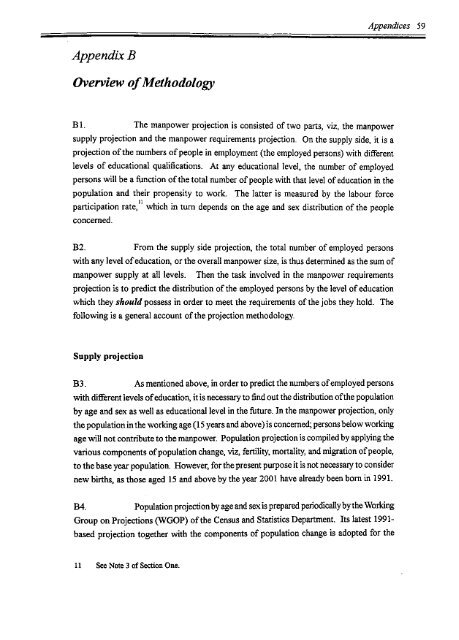Projected Manpower Requirements - HKU Libraries - The University ...
Projected Manpower Requirements - HKU Libraries - The University ...
Projected Manpower Requirements - HKU Libraries - The University ...
Create successful ePaper yourself
Turn your PDF publications into a flip-book with our unique Google optimized e-Paper software.
Appendices 59<br />
^«»iBm!iffliiii«miiB»i|B|^<br />
Appendix B<br />
Bl.<br />
<strong>The</strong> manpower projection is consisted of two parts, viz, the manpower<br />
supply projection and the manpower requirements projection. On the supply side, it is a<br />
projection of the numbers of people in employment (the employed persons) with different<br />
levels of educational qualifications. At any educational level, the number of employed<br />
persons will be a function of the total number of people with that level of education in the<br />
population and their propensity to work. <strong>The</strong> latter is measured by the labour force<br />
participation rate, which in turn depends on the age and sex distribution of the people<br />
concerned.<br />
B2. From the supply side projection, the total number of employed persons<br />
with any level of education, or the overall manpower size, is thus determined as the sum of<br />
manpower supply at all levels. <strong>The</strong>n the task involved in the manpower requirements<br />
projection Is to predict the distribution of the employed persons by the level of education<br />
which they should possess in order to meet the requirements of the jobs they hold. <strong>The</strong><br />
following is a general account of the projection methodology.<br />
Supply projection<br />
B3. As mentioned above, in order to predict the numbers of employed persons<br />
with different levels of education, it is necessary to find out the distribution of the population<br />
by age and sex as well as educational level in the future. In the manpower projection, only<br />
the population in the working age (15 years and above) is concerned; persons below working<br />
age will not contribute to the manpower. Population projection is compiled by applying the<br />
various components of population change, viz, fertility, mortality, and migration of people,<br />
to the base year population. However, for the present purpose it is not necessary to consider<br />
new births, as those aged 15 and above by the year 2001 have already been born in 1991.<br />
B4. Population projection by age and sex is prepared periodically by the Working<br />
Group on Projections (WGOP) of the Census and Statistics Department. Its latest 1991-<br />
based projection together with the components of population change is adopted for the<br />
11 See Note 3 of Section One.

















